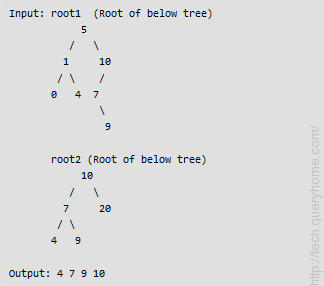Given two Binary Search Trees, find common nodes in them. In other words, find intersection of two BSTs.
Example:

We strongly recommend you to minimize your browser and try this yourself first.
Method 1 (Simple Solution) A simple way is to one by once search every node of first tree in second tree. Time complexity of this solution is O(m * h) where m is number of nodes in first tree and h is height of second tree.
Method 2 (Linear Time) We can find common elements in O(n) time.
1) Do inorder traversal of first tree and store the traversal in an auxiliary array ar1[]. See sortedInorder() here.
2) Do inorder traversal of second tree and store the traversal in an auxiliary array ar2[]
3) Find intersection of ar1[] and ar2[]. See this for details.
Time complexity of this method is O(m+n) where m and n are number of nodes in first and second tree respectively. This solution requires O(m+n) extra space.
Method 3 (Linear Time and limited Extra Space) We can find common elements in O(n) time and O(h1 + h2) extra space where h1 and h2 are heights of first and second BSTs respectively.
The idea is to use iterative inorder traversal. We use two auxiliary stacks for two BSTs. Since we need to find common elements, whenever we get same element, we print it.
// Iterative traversal based method to find common elements
// in two BSTs.
#include<iostream>
#include<stack>
using namespace std;
// A BST node
struct Node
{
int key;
struct Node *left, *right;
};
// A utility function to create a new node
Node *newNode(int ele)
{
Node *temp = new Node;
temp->key = ele;
temp->left = temp->right = NULL;
return temp;
}
// Function two print common elements in given two trees
void printCommon(Node *root1, Node *root2)
{
// Create two stacks for two inorder traversals
stack<Node *> stack1, s1, s2;
while (1)
{
// push the Nodes of first tree in stack s1
if (root1)
{
s1.push(root1);
root1 = root1->left;
}
// push the Nodes of second tree in stack s2
else if (root2)
{
s2.push(root2);
root2 = root2->left;
}
// Both root1 and root2 are NULL here
else if (!s1.empty() && !s2.empty())
{
root1 = s1.top();
root2 = s2.top();
// If current keys in two trees are same
if (root1->key == root2->key)
{
cout << root1->key << " ";
s1.pop();
s2.pop();
// move to the inorder successor
root1 = root1->right;
root2 = root2->right;
}
else if (root1->key < root2->key)
{
// If Node of first tree is smaller, than that of
// second tree, then its obvious that the inorder
// successors of current Node can have same value
// as that of the second tree Node. Thus, we pop
// from s2
s1.pop();
root1 = root1->right;
// root2 is set to NULL, because we need
// new Nodes of tree 1
root2 = NULL;
}
else if (root1->key > root2->key)
{
s2.pop();
root2 = root2->right;
root1 = NULL;
}
}
// Both roots and both stacks are empty
else break;
}
}
// A utility function to do inorder traversal
void inorder(struct Node *root)
{
if (root)
{
inorder(root->left);
cout<<root->key<<" ";
inorder(root->right);
}
}
/* A utility function to insert a new Node with given key in BST */
struct Node* insert(struct Node* node, int key)
{
/* If the tree is empty, return a new Node */
if (node == NULL) return newNode(key);
/* Otherwise, recur down the tree */
if (key < node->key)
node->left = insert(node->left, key);
else if (key > node->key)
node->right = insert(node->right, key);
/* return the (unchanged) Node pointer */
return node;
}
// Driver program
int main()
{
// Create first tree as shown in example
Node *root1 = NULL;
root1 = insert(root1, 5);
root1 = insert(root1, 1);
root1 = insert(root1, 10);
root1 = insert(root1, 0);
root1 = insert(root1, 4);
root1 = insert(root1, 7);
root1 = insert(root1, 9);
// Create second tree as shown in example
Node *root2 = NULL;
root2 = insert(root2, 10);
root2 = insert(root2, 7);
root2 = insert(root2, 20);
root2 = insert(root2, 4);
root2 = insert(root2, 9);
cout << "Tree 1 : ";
inorder(root1);
cout << endl;
cout << "Tree 2 : ";
inorder(root2);
cout << "\nCommon Nodes: ";
printCommon(root1, root2);
return 0;
}
Output:
4 7 9 10
